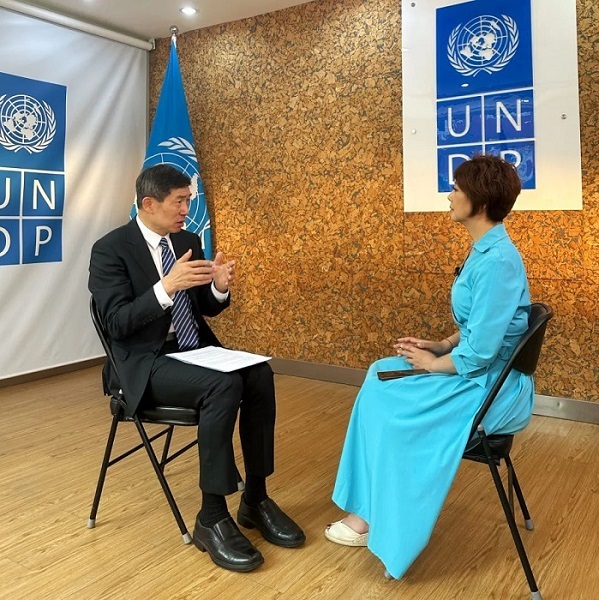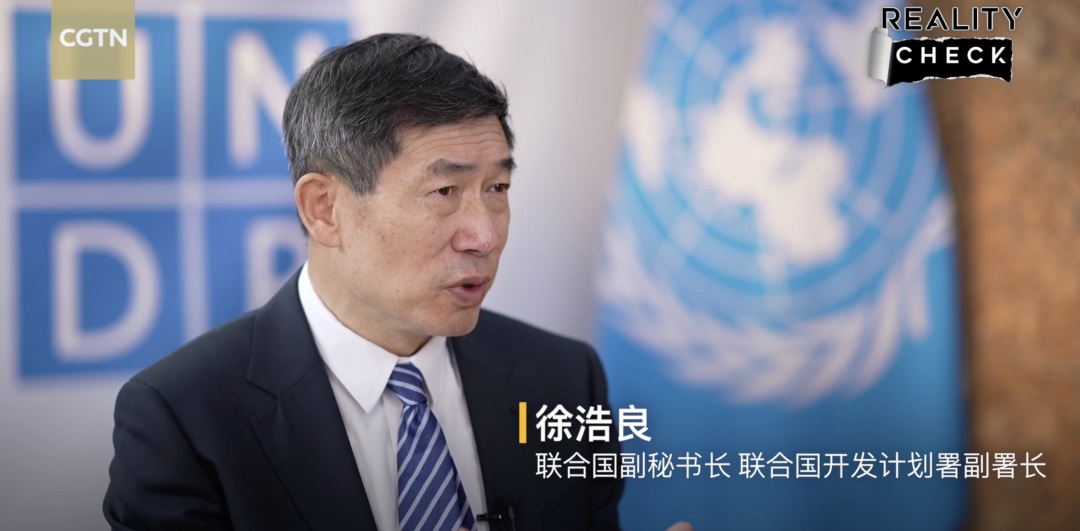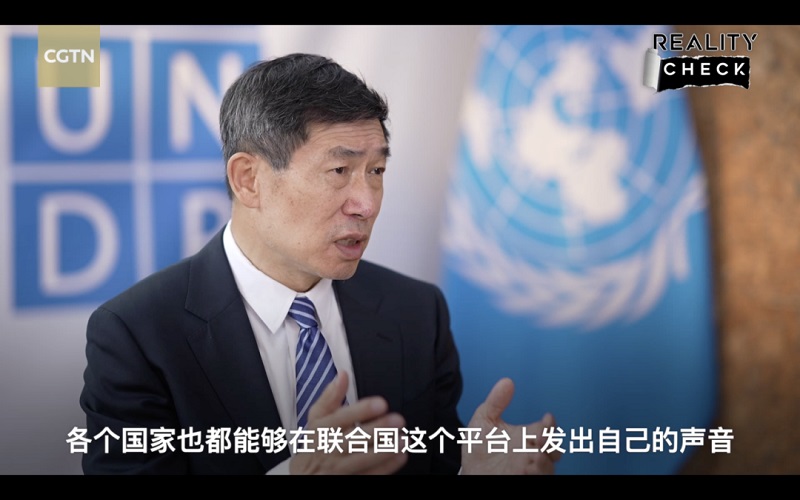
联合国副秘书长兼开发计划署副署长徐浩良近日在北京接受了CGTN主持人田薇的专访,深度探讨了全球可持续发展的多边解决方案、区域组织与国际组织的作用以及可持续发展目标如何走向正轨等话题。
徐浩良先生在专访中谈到了发展中国家面临的资金、技术和能力建设等挑战,以及全球可持续发展目标SDGs的落实困难。他指出了发达国家、多边金融机构和各方投资对发展中国家资金的影响,以及发展中国家在国际合作和发展问题上的变化。他认为联合国机构应该适应新形势,打造有效的发展方案,同时各国自身也要加强国家治理能力等方面的努力。同时副秘书长提到,各国组织的努力在2030可持续发展目标下是一致的,需要协同合作实现全球繁荣、包容与和平。
共创韧性未来,推动可持续发展

最新进展
早在四月份,我们就听到了联合国秘书长关于可持续发展目标进程的报告,以下是他的发言。2030可持续发展目标难以实现,近一半目标偏离轨道,他对此敲响了警钟。与此同时,我们在30%以上的可持续发展目标上停滞不前,或出现倒退。从四月份到现在,已经三个月了,您能告诉我们最新的进展吗?
We heard from the UN Secretary-General back in the month of April in terms of the SDG progress report, and here is what he said. He sounded an alarm about the lack of progress on Sustainable Development Goals, progress on 50% is weak and insufficient. Meanwhile, we have stalled or gone into reverse on more than 30% of the SDGs. Now, from April to now three months already, can you give us an update on where we are?
徐浩良:
秘书长的讲话反映了在 2030 年可持续发展议程陷入了危机。这是对于现实的检验。此外,还有更多令人警醒的数字:在我们有数据可查的 140 个目标中,只贯彻了 12% 的目标。这能反映出相当严重的问题。我们面临的挑战也呈现在我们的其他研究中。例如,联合国开发计划署自1990 年以来一直在发布人类发展指数。自三十年前开始追踪这一数据以来,过去两年,人类发展的总体成就有所下降。在 2020 年至 2023 年期间,由于新冠疫情、气候危机和乌克兰战争的影响,这一下降趋势更加严重。仅在过去几年中,就有1.65亿人口陷入贫困。因此,我们在这方面确实面临着很多挑战。
What the Secretary General has said is a reflection of the serious lack of progress necessary to achieve sustainable development by 2030. This is a reality check. Moreover, more startling indicators emerge: out of the 140 targets for which we have data, only 12% are on track. The problem is quite serious. In some of our other studies, for example, we have indicators that show the challenges we are facing. The UNDP has been publishing the Human Development Index since 1990. In the last two consecutive years, we see a decline in overall human development achievements since we started tracking this data three decades ago. And between 2020 and 2023, this decline is compounded by the impact of the Covid-19 crisis, the climate crisis, and the war in Ukraine. 165 million people fell into poverty in just the last few years. So, we really have a lot of challenges in this regard.
明确方案
这些挑战的确摆在我们面前,那我们有明确的解决方案吗?
These challenges are in front of us, do we have clear solutions?
徐浩良:
更具体地来讲,我们看到世界正在前进,但各国前进的速度却大相径庭,因此我认为,这是一个挑战。目前世界上大约有 65 个国家正在以每年 4% 或更高的增长率发展,它们的增长速度还算不错。但同样,约有 65 个国家的增长率低于 2%,这意味着它们的增长水平非常低。另有 55 个国家的总增长率在 2%到 4%之间,这意味着这些国家正在发展,但速度截然不同。目前,更多的发达国家主要通过调整利率,应对过去几年在宏观经济方面面临的一些挑战。因此,它们现在试图降低通货膨胀的利率。然而,对许多发展中国家来说,它们正面对着一些发达国家(如美国联邦储备委员会和欧洲中央银行)货币政策带来的后果。对发展中国家来说,不同的发展速度和利率变化带来的挑战意味着,它们不仅要处理过去积累的超额债务,而且还要应对许多发达国家现今不断上升的利率。它们正背负着高额借贷,以满足未来发展支出。
More specifically, we see a world that is moving forward but at very different speeds, so that is a challenge. Currently, about 65 countries in the world are moving forward at a 4% or more growth rate a year. So, they are moving at a modestly good speed of growth. But again, about 65 countries are moving at less than a 2% growth rate. That means they are experiencing very low levels of growth. About another 55 countries are moving between 2 to 4% of the gross rate. This means these countries are moving, but at very different speeds. Now, more developed countries are dealing with some of the challenges in the macroeconomics that they have faced over the last few years, mainly through adjustments of the interest rates. They are now able to pivot towards trying to lower the interest rates that they have put forward to deal with inflation. However, for many developing countries, they are dealing with the consequences of the monetary policies of some developed countries, such as the US Federal Reserve and the European Central Banks. The challenge of all these different speeds and interest rate changes means that for developing countries, many of them are dealing with the debt overhang they have accumulated in the past, but also now with the rising interest rates in many developed countries. They are facing the high cost of borrowing for future development expenditures.
周期性挑战
您在发展领域工作了几十年,以前见过这样的现象吗?
You have been working in the development area for decades, have you ever seen something like this before?
徐浩良:
我们已经认识到了许多挑战的周期性,比如过去的危机。但我想说的是,这一次的情况似乎真的很严重。根据联合国和联合国开发计划署的研究,40%的发展中国家正处于困境中。它们濒临无力偿还债务的境地,更不用说借贷的资本了。举例来说,仅偿还债务就占许多发展中国家预算的 10%以上,有时甚至高达 20%。这使它们几乎不可能投资于他们每天需要处理的事情,更不用说数字化转型、能源转型等对发展至关重要的转型。
I think we have seen cyclical challenges of many problems, such as the issue of crisis in the past, but I would say that this time around, the situation seems to be really serious. Based on our studies in the UN and in UNDP, 40% of the developing countries are facing the question of that distress. That means they are on the verge of not being able to repay the debt service charges or let alone the capitals of the borrowing. Many developing countries are paying more than 10% or sometimes 20% of their budgets just for that service, for example. This makes it almost impossible for them to not only invest in what they need to deal with every day, let alone spend money for critical transformations that are needed, such as digital transformation, energy transition, and so forth.
发展受阻
这就意味着它们实际上是被此前的债务拖住了脚步,无暇规划未来,同时也在承受着当下的痛苦。
They are actually held back by the debts of yesterday, preventing them from planning for tomorrow while at the same time suffering today.
徐浩良:
过去几年的多重危机给所有国家带来了巨大压力,最不发达的国家不得不增加预算支出以应对危机的影响,如增加社会保障支出、医疗服务费用、应对新冠疫情等等。过去几年间的诸多危机是我们从未见过的。
The multiple crises of the last few years have put so much pressure on all countries, but the most undeveloped countries who have had to increase budgetary expenditure, to deal with the impact of crises, such as increasing social protection expenditures, the cost of medical services for their population, to deal with the diseases of the Covid-19, and so forth. This multiple crisis of the last few years is something that we have not seen before.
全球解决方案
从联合国的角度来看,您如何看待许多人所说的“全球南方”(主要是发展中国家和新兴经济体)试图在全球治理中寻求更大的发言权的迫切和愿望,并努力确保它们的诉求得到倾听,同时在全球范围内寻求解决方案?
From the UN perspective, how do you see the urgency and the desire coming from what many call the global south, mainly developing countries and emerging economies trying to seek a bigger voice in global governance, and also trying to make sure their issues are being heard while at the same time, solutions can be sought globally?
徐浩良:
可持续发展目标议程,即 2030 年可持续发展议程,是一项全球议程,联合国所有国家都已批准。目前正处于今年 9 月即将举行的可持续发展目标峰会的筹备阶段,成员国之间就许多领域缺乏进展、对 2015 年制定的目标重新作出承诺展开了大量讨论。就在本月初,成员国就可持续发展目标峰会的政治宣言达成一致。该宣言重申了他们对《2030 年议程》和可持续发展目标的愿景。他们呼吁采取必要的转型行动,以弥补最后的进展,加快可持续发展目标的实现,提供充足的资金,并提高能力,帮助发展中国家实现对世界人民的承诺。这需要政治承诺。正如我前面提到的,发展中国家如今面临的最大挑战之一是融资问题,即充足的发展资金。
The SDGs agenda is the 2030 development agenda. It's the universal agenda, so all countries of the United Nations have endorsed it. This was in the lead-up to the SDG summit in September this year. There has been a lot of discussion among member states about the lack of progress in many areas and recommitting themselves to the goals that they have set up in 2015. In early August this year, just earlier this month, member states agreed on a political declaration for the SDG summit. This declaration reaffirmed their commitment to Agenda 2030 and the Sustainable Development Goals. They called for transformative actions that are needed to make up the last progress, acceleration of SDGs, adequate financing, and capacity development to enable developing countries to materialize the promise that has been made to the people of the world. There is a political commitment for this. As I mentioned earlier, one of the biggest challenges today that developing countries are facing is the question of financing. Adequate development financing.
这方面,联合国秘书长提出了可持续发展目标激励措施,通过一系列具体行动以应对发展融资问题 。他在可持续发展目标激励措施中提倡的第一个方面是,世界各国,特别是二十国集团的主要发达国家和主要发展中国家,通过采取一些具体措施,如降低长期借款成本和进一步暂停偿债,解决发展中国家的债务困扰,并在借贷协议中自动规定,如果发生某些事件,借贷国将免除偿债义务。这是解决债务问题的一个方面。具体解决方案的另一个方面是,要求多边开发银行在其现有资产负债表的范围内,扩大杠杆作用,提供更多贷款。他呼吁多边开发银行将贷款从每年 1000 亿美元增加到 5000 亿美元。
Here, the Secretary General of the United Nations has put forward a proposal, what he calls the SDG stimulus, that focuses on the question of finance through a number of concrete actions. In the first area that he called for in this SDG stimulus is for the world, especially the G20 major developed and major developing countries, to support the resolution of debt distress of developing countries by taking a number of concrete measures, such as lowering the cost of long-term borrowing and further suspending payment of debt servicing, to build automatically in lending agreements that relieve borrowing countries the obligations to pay if certain events take place. This is one area to deal with the debt issue. Another area in which he proposed concrete solutions is to ask multilateral development banks to leverage more of what they can to lend more within their existing balance sheets. He calls for multilateral development banks to increase their lending from $100 billion a year to $500 billion a year.
官方发展援助
我们看到发达经济体向发展中经济体提供的资金不足。比如二十国集团在过去几年中宣布的气候变化问题尚未实现。另一个问题是发达经济体的利率问题,一些经济学家认为,这是发展中国家目前面临的许多问题的根源。如果不从根本着手,又如何能充分解决这些问题呢?
We are seeing a lack of funding coming from developed economies to developing ones. Earlier on the climate change issue declared by the G20 over the past few years has not been realized. The other thing is the issue of interest rates by developed economies, in the US and also in Europe, that is as some economists argue the root cause of many of the problems that developing countries are facing these days. Without addressing the root causes, how would the problems be addressed sufficiently?
徐浩良:
我想这个问题的回答还是很复杂的。首先,请允许我谈谈官方发展援助问题。传统上一谈到发达国家帮助发展中国家,人们就会立即想到官方发展援助问题。但事实上,官方发展援助资金每年约为 1450 亿美元。从绝对值来看,比去年有所增长,但这一增长主要是由于发达国家对新冠疫情的应对,以及为应对俄乌冲突后果而支出的费用。因此,通过官方发展援助开展的实际发展合作并没有大幅增加。即使每年向发展中国家提供 1400 亿美元,也是远远不够的,因为发展中国家的规模也在扩大。因此,官方发展援助的相对重要性已经发生了变化。
I think the answer to this question is complicated. First, let me talk about the question of Official Development Assistance. You mentioned the financing from developed countries for developing countries, and traditionally, the question of ODA immediately comes to mind when you talk about developed countries helping developing countries. But the fact is that the ODA is at about 145 billion dollars a year. It has not really increased much, and there's been some increase over the last year in absolute terms. But this increase is mainly due to the responses of developed countries to the Covid-19 crisis and expenditures at home to respond to the consequences of the war in Ukraine. So, the real development cooperation through this ODA has not increased substantially. This being said, even with $140 billion a year to developing countries, it is not sufficient by any means, because the size of developing countries has also increased. Therefore, the relative importance of ODA has changed.
“全球南方”
联合国如何看待这些来自全球南方国家的合作意愿和呼声呢?这些声音如何融入并推动联合国2030可持续发展议程?我想这是联合国中期峰会可能要解决、也应该解决的一个大问题。
How does the UN look at these ever-stronger desires and voices coming from the Global South? How are their voices likely to work into the agenda and the pathway toward 2030? This is a big question I guess that the midpoint summit in the UN is likely to address and should be addressed.
徐浩良:
有许多区域性的多边组织和倡议发展十分迅速,以金砖国家为例。据我所知,目前有超过20个国家已经申请加入金砖国家合作机制。与此同时,七十七国集团和中国在联合国也有强大的话语权,其他区域性组织也是一样。联合国始终发挥着作用,让各方的声音都能够被听见,各个国家也都能够在联合国这个平台上发出属于自己的声音。因此,联合国依然是最具代表性的国际组织,让各方声音都有展示的舞台。相比我们之前谈到的所有关于可持续发展目标缺乏进展的问题,我们现在正在谈论更具体的方面,如世界范围内女性赋权和性别平等进程的倒退。联合国开发计划署最近刚刚发布了一份相关报告。对于所面临的问题,整个世界急需多边解决方案。依靠双边机制或地区机制解决问题是远远不够的。金砖国家探讨的事务也好,或是二十国集团关注的议题以及其他区域性组织聚焦的话题,最终都需要取得联合国所有成员国的支持,只有这样才能在国际上具有合法性。我认为,区域性组织和国际组织的诉求之间并不存在矛盾。如果区域性组织植根于2030可持续发展议程,与可持续发展目标保持一致,那么我们就是同行者。因此,我们需要各方声音形成合力,让世界得以发展,让各国人民受惠,不让任何人掉队,让世界变得更加和平。
Yes, it is a fact that there are quite a few regional or other multilateral organizations and initiatives that are developing very fast, BRICS, for example, my understanding is that more than 20 countries have applied to be members of the BRICS. At the same time, the G77 and China also have a very strong and distinctive voice in the United Nations. So are other regional groupings. And I would think the United Nations is still the place where all voices can be heard. And all voices have a stage to have their voices heard. So the United Nations is still the most representative international organization that can provide space for these voices. For all the problems that we talked about earlier, the lack of SDG progress, and we are talking about more specific issues such as the backlash of women's empowerment and gender equality in the world. UNDP just published a report about it recently. For all these problems, we, the world, urgently need multilateral solutions, because bilateral solutions or regional solutions are not adequate. For the issues that the BRICS are discussing, G20 are discussing, or other regional groupings are discussing, at the end of the day, you need the support of all membership of the United Nations for this to have international legitimacy. I don't think there is a contradiction between what the regional or other international groupings are pushing for. If they are rooted in the Agenda 2030 and in the SDGs, I think we are on the same page. So, we need the synergies of all in our voices so that the world is developing to be more prosperous for everybody. Leaving no one behind and to be more peaceful.
各国努力
参与者不仅是多边集团或机制,而且还有国家个体。一些国家正在为其合作伙伴提供新的想法和解决方案。既然我们现在在北京,我就举一个中国的例子。中国一直在提出全球发展、全球安全和全球文明等倡议,同时通过“一带一路”倡议,与合作伙伴共同发展。这些都是一个国家号召世界各地合作伙伴的启示。那么,您如何看待来自各个国家的努力,包括中国,这个全球最大的发展中国家之一?此外,您如何看待这些努力为联合国和其他全球机制内的讨论和实施提供的新动力?
Not only multilateral groupings or mechanisms but also individual countries. Some of them are providing new ideas and solutions to their partners. Since we are based in Beijing, I'll just provide an example from China. China has been providing initiatives such as the Global Development Initiative, Global Security Initiative, and Global Civilization Initiative while at the same time working with partners on development issues through the Belt and Road Initiative. These are inspirations coming from one country with its partners around the world. So, how do you see these efforts coming from individual countries, including China, one of the largest developing countries globally? Furthermore, how do you envision these efforts providing new momentum for discussions and implementations within the UN and other global mechanisms?
徐浩良:
我认为,国家个体,特别是较大的和新兴的发展中国家正在采取自己的举措来支持全球发展,这是一种促进。我认为这是健康的,我们知道 2030 年可持续发展目标的挑战是全球性的,解决办法也需要是全球性的。秘书长已经明确表示,我们需要一个挽救可持续发展目标的计划,因此需要每个人的努力,帮助我们面对挑战。您提到了中国的一些倡议,比如全球倡议,政府已经非常明确地表示这些倡议与支持实现可持续发展目标是一致的,我认为这是受欢迎的。
I think this is only nurture that individual countries, especially larger and emerging developing countries are taking their own initiatives to support global development. I think it is healthy and we know that the challenges of the SDGs at general 2030 are global, and the solutions also need to be global. The secretary general has said very clearly that we need a rescue plan for the SDGs, so we need the effort of everyone to actually help us deal with the challenges we're facing. You mentioned the initiatives of China such as Global Initiative which the government has said very clearly that is aligned to support the achievement of the SDGs, so I think this is a welcome.
发展变化
我了解到您之前访问了印度。现在您以个人的身份访问中国,已经在办公室开始工作了。这样的旅行如何为您提供更多的思路和现实检验?是否能帮助您了解发展中国家和全球南方国家如何应对当今的挑战呢?
I saw you visit to India earlier and certainly now you are here as a private citizen visiting China, but certainly you're already working in the office. So how do travels like these be able to provide you with more ideas and reality check about how developing countries and the global south are working today?
徐浩良:
正如我之前提到的,现实情况正在发生变化。过去,在发展合作方面,主要是发达国家、经济合作与发展组织成员国、发展援助委员会成员国向发展中国家提供资金和技术解决方案。虽然这仍然是极其必要的,但过去14年来,发展中国家的经济规模和能力也显著增长。因此,发展合作的性质,国际合作的性质正在发生变化。对我们而言,这意味着我们也需要审视自己在支持实现可持续发展目标方面的角色。例如,联合国开发计划署试图探究当今发展挑战的复杂性,并努力实现规模化的影响 。我们所讨论的所有问题,比如性别倒退和基于性别的暴力,这些问题如今变得非常严峻。根据我们最新的研究,全球范围内的妇女在实现自身潜力方面,平均只能达到男性的72%。此外,在许多国家,我们需要应对诸如城市垃圾填埋场将不得不提前20年关闭的挑战,导致一个拥有1000万人口的城市无法处理固体废物。因此,一些政府寻求我们的援助。在应对气候挑战、城市问题时,没有问题是简单的;没有一个单一的部门能够解决其中任何一个问题。这些问题相互关联,可持续发展目标也相互关联。
I think the reality, as I mentioned earlier, is that the world is changing. In the past, when it comes to development cooperation, it was about developed countries, OECD countries, the Development Assistance Committee countries providing financing and technology solutions to developing countries. While this is still critically needed, the size of the economy and the capacities of developing countries have also increased substantially over the last 14 years. So, the nature of development cooperation, the nature of international cooperation, has been changing. What this means to us is that we also need to look at our role today in supporting the achievement of the SDGs. For example, what UNDP is trying to do is to look at the complexities of today's development challenges and also try to achieve impact at scale. All the problems we've been talking about, like the gender backslide and gender-based violence, are so serious today. Based on our latest studies, women in the world, on average, can only achieve 72 percent of the potential of men when it comes to achieving their own potential. Moreover, in many countries today, we're asked to deal with challenges such as cities' landfills being 20 years ahead of schedule, leaving a city of 10 million people with no place for solid waste. So some governments ask for our assistance. And when it comes to climate challenges, when it comes to urban issues, no problem is simple; no single ministry can solve any of these problems. The issues are interconnected, the SDGs are interconnected.
因此,我们正试图思考,在这种情况下我们能做些什么,现在的政府很可能不需要我们提供传统的、单点的解决方案,他们在这方面拥有自己的能力。但我们都面临的挑战是,大家感到自己陷入了某种困境。政府现在也感到自身陷入了某种困境,尽管我们拥有所有的解决方案,甚至拥有资金来源,但我们并没有取得进展。许多人认为,他们之所以感到困境,是因为他们没有看到未来的机会。因此,我们如何应对这些挑战?例如,在某些国家,我们被要求应对人口减少的问题,人们为了工作而离开自己的国家,这不是一个简单的问题,因为这个问题不仅仅涉及到人口老龄化,有时人口老龄化是人口减少的一个原因,但受过教育的公民离开自己的国家,寻求其他地方的机会,反映出国内复杂的挑战。联合国开发计划署正试图通过系统变革的方法与各国政府合作,应对这些需要不同方式应对的挑战。因此,我可以在适当的时候进行更详细的阐述。我们还在大规模地支持各国政府应对融资问题。例如,我们目前正在支持全球85个国家制定所谓的综合国家融资框架,旨在将所有融资来源整合在一起,支持他们确定的发展重点。我们正在努力在大规模范围内产生影响,应对当今发展挑战的复杂性。
What we're trying to do is okay, what can we do in this situation, because the traditional, let's say, single point-based solutions, our governments most likely don't need us, they have their own capacities today. But the challenge that we're all facing is the sense of being stuck today. The governments feel we're stuck somewhere. We're not making progress when we have all the solutions, even we have money. And a lot of people use, for example, they are stuck because they're not seeing the opportunities for their future. So how do we deal with these kinds of challenges? In some countries, for example, we've been asked to deal with the question of depopulation, people are leaving their countries for jobs and so this is not a simple issue, right? It's not just about aging, sometimes aging is one source of depopulation, but the fact that educated citizens are leaving their country seeking opportunities elsewhere reflects complex challenges at home. What the UNDP is trying to do is to work with our governments through a system-change approach to deal with these kinds of challenges that call for a different approach, for example. So, I can elaborate more at a proper time. We're also working at scale to support our governments to deal with the question of financing. For example, we are supporting at this time 85 countries in the world to develop what's called Integrated and National Financing Frameworks (INFF) that seek to put all sources of financing together to support their stated development priorities, for example. So there are a lot of other issues we're trying to do to achieve impact at scale, to deal with the complexities of today's development challenges.
最新进展
在我们面临着许多问题的时候,正如我们之前提到的一些问题,人们将很多希望和期望寄托在联合国等组织身上。但正如您所提到的,人们对于陷入困境的感觉以及目前缺乏进展的现状感到幻灭。您在联合国工作期间亲历了多年,见证了其演变。从历史的角度来看,您如何看待联合国的现状?联合国目前是否面临生死存亡的关键时刻?
At a time when we have so many problems in the world as we mentioned some of them earlier, people put a lot of pin and a lot of hopes and aspirations to organizations such as the United Nations. But as you also mentioned that people are disillusioned by the feeling of being stuck and also by the lack of progress going on right now. You have seen the UN while working as a member of the staff evolve over the years. From a historic perspective, how do you see where the UN is? Is this a life-and-death situation that UN is facing right now?
徐浩良:
这是一个非常难以回答的问题。以可持续发展目标峰会为例。我提到了秘书长提出的可持续发展目标刺激计划,以应对融资问题。但就可持续发展目标峰会本身而言,联合国还提出了另一组高影响力倡议的计划,涵盖了联合国认为能够刺激和加速可持续发展目标的实现。例如,在教育方面,必须强力推动教育。在就业方面,我们的研究表明,就业对于包容性增长至关重要,这不仅仅是增长,还要实现让每个人都有机会的包容性增长。能源转型领域为今天尚未通电的7亿人提供能源,同时在这个过程中也创造了许多优质的就业机会。这些高影响力倡议还包括数字转型、治理和其他一些推动因素。因此,联合国提出了一系列倡议,旨在在可持续发展目标峰会后立即采取具体行动,以确保未来的七年半时间回归正轨、实现目标。然而,这仅仅是联合国可以做到的。而对于问题的另一方面,解决方案的影响和规模也在很大程度上取决于各国政府。
It's a very hard question to answer. Take the SDG summit as an example. I mentioned this SDG stimulus plan that the Secretary-General has put forward to address the question of financing. But for the SDG Summit itself, the UN is also putting forward another set of initiatives called the high-impact initiatives in different areas of transformation that the UN believes can stimulate and accelerate the achievement of SDGs. Such as education, there has to be a strong push for education. Jobs, our study has shown that jobs are critical for inclusive growth, and not just growth, inclusive growth that everybody has the opportunity. The areas of energy transition which provide energy to 700 million people today, I believe still don't have electricity, but also create great jobs in the process. These high-impact initiatives also include some of the enablers such as digital transition, governance, and others. So, there's a set of initiatives that the UN is putting forward to take concrete actions immediately after the SDG summit so that the next seven and a half years are not business as usual. But this is what the UN can do. But to the other part of the question, the impact and the scale of the solutions also depend a lot on our country governments.


